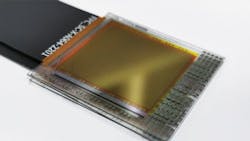Novel Sensor Material Demonstrates Better Color Image Reproduction Than Silicon
Researchers have developed and tested image sensors made of perovskite rather than silicon. Compared with silicon, they say perovskite enables better color reproduction and fewer image artefacts with less light.
Most image sensors are made of silicon, which absorbs light over the entire visible spectrum. This is why manufacturers of RGB image sensors filter the incoming light with what is known as a color filter array (CFA), so that each pixel receives only a third of the color information from the visible light spectrum, either red, green, or blue.
The researchers are associated with both ETH Zurich (Zurich, Switzerland), a technical university, and Empa (Dübendorf, Switzerland), a research institute specializing in the material sciences. They have been researching perovskite-based image sensors for nearly a decade. In the most recent study, published in Nature (http://bit.ly/3Gm2aYV), they demonstrate that perovskite can be more sensitive to light and produce better color reproduction at a higher resolution than conventional approaches.
Related: Seeing is Believing with Today's CMOS Image Sensor Technology
To create the sensor, they exploit the physical properties of perovskite. If the substance contains slightly more iodine ions, it absorbs red light. The researchers add more bromine for green and more chlorine for blue.
They then stack the pixels for red, green and blue on top of each other in the image sensor—rather than side-by-side as is the case with silicon sensors. This structure works because the layers of perovskite photodetector film are transparent to the other wavelengths, so they can be stacked without losing light, the researchers explain.
They say their design eliminates the problems associated with demosaicing algorithms, which reconstruct a color image by figuring out the missing colors for each pixel based on the colors captured by nearby pixels. However, the demosaicing process can lead to images that are fuzzy and distorted, they say.
Testing the Experimental Perovskite Sensor
For the research study in Nature, they built two fully functional thin-film perovskite image sensors and compared their performance to two other sensors:
- A Sony (Tokyo, Japan) IMX249 sensor with a CFA
- A Foveon-type imager fom Sigma (Kawasaki, Japan), which uses a three-layer structure to capture the red, green, and blue colors.
They compared the color reproduction accuracy and external quantum efficiency (EQE) for each approach.
Related: Thermal Ranging Technique Delivers Detailed Images
They found that the perovskite sensors had an external quantum efficiency of 50% (red channel), 47% (green channel) and 53% (blue channel). These results are nearly two times higher than the EQE for the CFA technology.
The researchers say the experiments also showed that the perovskite sensors provide more precise color reproduction.
In the next step, the researchers want to further reduce the size and increase the number of pixels in their perovskite image sensors. Their two prototypes have pixel sizes between 0.5 and 1 millimeters.
Related: Experimental Camera Captures Millions of Images Per Second
As the authors conclude in the journal article, “Beyond their readily tunable bandgaps, perovskites may potentially act as a more technologically simple alternative to current state-of-the-art backside illuminated complementary metal–oxide–semiconductor (CMOS) image sensors for maximization of active sensor area.”
About the Author
Linda Wilson
Editor in Chief
Linda Wilson joined the team at Vision Systems Design in 2022. She has more than 25 years of experience in B2B publishing and has written for numerous publications, including Modern Healthcare, InformationWeek, Computerworld, Health Data Management, and many others. Before joining VSD, she was the senior editor at Medical Laboratory Observer, a sister publication to VSD.


